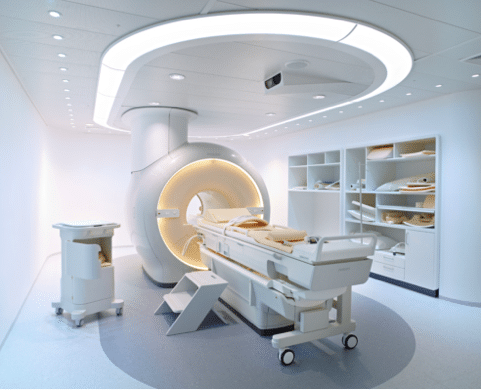
Medical tech company Profound Medical (Profound Medical Stock Quote, Chart, News TSX:PRN) is down by close to half this year, but Raymond James analyst Rahul Sarugaser is staying bullish on the stock, maintaining a “Strong Buy 1” rating in an update to clients on Wednesday.
With its headquarters in Mississauga, Ont., Profound Medical develops magnetic resonance guided ablation procedures for treatment of prostate disease, uterine fibroids, and palliative pain treatment and is now commercializing its TULSA-PRO non-invasive, image-guided therapeutic tech for the ablation of pathologic prostate tissue.
Sarugaser’s latest analysis comes after a call with Dr. Joseph Busch, a board-certified radiologist with over 50 years of experience specializing in interventional and diagnostic Radiology at the Busch Center in Alpharetta, GA. According to Sarugaser, Dr. Busch has treated more than 130 patients with Profound Medical’s TULSA device, which combines real-time magnetic resonance imaging with transurethral, robotically-driven therapeutic ultrasound and closed-loop thermal feedback control
“Dr. Busch believes TULSA will set the new standard in prostate treatment, both cancer and non-malignant prostate conditions,” Sarugaser said. “While radical prostatectomy (and radiation treatment) represents today’s standard of care for treating high risk prostate cancers, Dr. Busch believes this massively destructive, quality-of-life reducing treatment approach is on the way out (just like radical mastectomy fell out of favor for addressing breast cancer).”
“Therapies like TULSA that conserve quality of life while delivering best-in-class life-extending/curative treatment will, in Dr. Busch’s view, become physician’s go-to option,” Sarugaser added.
Dr. Busch believes Profound’s TULSA treatments in particular will benefit from achieving permanent reimbursement from the Centers for Medicare & Medicaid Services (CMS).
“[Profound] has been outstanding,” Dr. Busch said. “I don’t know much about the business, but the scientific team is really impressive. I’ve been in radiology a long time and I’m very familiar with how different companies support [their users]; I couldn’t ask for a better professional team. They’re at my beck and call all the time. It’s just good medicine.”
The TULSA treatment has taken off in Dr. Busch’s clinic, as the clinic performed 71 procedures in its first year with TULSA service, a significant spike in demand when compared to the clinic’s initial projection of 39 procedures for the year. The company’s TULSA appointments are also booked through the end of January 2022 while expecting to treat 3-4 patients a week in December; according to Sarugaser, Dr. Busch indicated that he is considering installing a second TULSA and MR unit in his clinic.
“TULSA works every time,” Dr. Busch said. “You sit there for two hours ablating a gland, and the TULSA works like a clock. You want that consistency and reliability.”
Dr. Busch’s rationale for adopting TULSA was that prostate cancers curable by standard-of-care treatment are likely to be curable by TULSA, and cancers that are likely to recur and progress are also likely to recur and progress following TULSA treatment, though the key difference in TULSA comes down to preserving quality of life, with Dr. Busch noting that, among the 131 patients he’s treated, none of them require diapers or pads, nor were they prescribed narcotics after the procedure.
Dr. Busch offers favourable comparisons for TULSA to generally accepted treatments like HIFU (lack of precision and accuracy, and not enough energy produced to treat an anterior lesion), cryoablation and focal lasers, both of which lack the same accuracy and control of TULSA in Dr. Busch’s view, while any ultrasound fusion technology will come with misregistration problems.
Dr. Busch believes calcification of the prostate gland is the only real blockade for TULSA, as patients with prohibitive levels of calcium may have to undergo surgery and radiation to treat their cancer.
In Dr. Busch’s view, TULSA’s adoption in big-name teaching hospitals like Johns Hopkins University, the Mayo Clinic, Stanford, Yale, and UCLA is critical to driving awareness for the device, both among patients and evidence-driven urologists and radiologists.
Sarugaser’s financial projections for the company see Profound reaching $9 million in revenue in 2021 for a projected year-over-year increase of 28.6 per cent. He then projects Profound to reach another level in 2022 with a forecasted jump to $21 million for potential year-over-year growth of 133.3 per cent. Sarugaser’s EV/Revenue multiple projections also show Profound in a positive position, as he forecasts a drop from 27.9x in 2020 to 23.8x in 2021, with a further projected drop to 9.8x in 2022.
Meanwhile, Sarugaser continues to forecast EBITDA losses, with loss projections of $21 million in 2021 and $27 million in 2022 after reporting a $14 million loss in 2020. Consequently, the EV/EBITDA multiple projections continue to be negative, moving from a reported -14.3x in 2020 to a projected -9.6 in 2021, then moving to a projected -7.6x in 2022.
“Why TULSA?” said Dr. Busch. “Because it’s a better technology. It’s easier to use. It’s safer to use. It’s more accurate, and you have more control. I think when [doctors] see this, and they see the same [cancer] outcomes, why would you take patients to surgery? If we continue showing these kind of outcomes, TULSA is going to be hard to beat. This will catch on. More and more patients are demanding TULSA, specifically.”
Leave a Reply
You must be logged in to post a comment.





 Share
Share Tweet
Tweet Share
Share




Comment